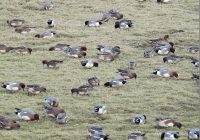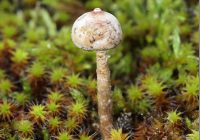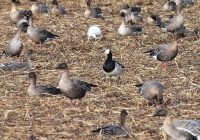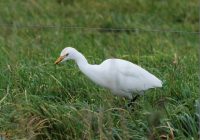Dr Phil Smith’s Wildlife Notes
December 2016
In complete contrast to last year, this desperately dry autumn and winter continued throughout December, with only nine days producing measurable rainfall. Much heralded in the media, two named storms were little more than damp squibs, producing an hour or two of light rain and a fresh breeze. Predictably, the dune water-table remained stubbornly low, a visit to Cabin Hill National Nature Reserve finding almost no surface water in the slacks and, as a consequence, only three Common Snipe. A Chiffchaff calling from the willows eventually gave close views showing no hint of greyness and therefore typical of the western European race, rather than one from Scandinavia or Siberia that occasionally turn up here in winter.
While the dunes are always rather quiet in December, the Ribble marshes invariably provide some excitement. Over 2500 Wigeon close to the coastal road embankment at Crossens on 5th were an impressive spectacle, while later in the month, 1100 Golden Plover and a Great White Egret added further interest from the same viewpoint. In addition to the now ubiquitous Little Egrets and regular Great Whites, the Cattle Egret, is being seen much more often in our area, having started to breed in the UK in 2008. An email from Tim Vaughan alerted me to one near Hightown on 11th that was patrolling the verge right next to a fairly busy road, completely ignoring the traffic. What it was finding to eat at this time of year is a mystery, as this species usually relies on insects disturbed by grazing animals, especially of course cattle.
On 6th, I joined a group of about 30 Biodiverse Society volunteers and organisers on a walk from Ainsdale Discovery Centre to the Green Beach. This fascinating pioneer habitat is not seen at its best on a dull cold December day; nevertheless a variety of gulls and waders competed for attention with a perky Stonechat. Ben Deed of Merseyside BioBank collected two notable fungi: a rust called Puccinia recondita on leaves of Sand Couch and an ergot from Common Cord-grass that rejoices in the name Claviceps purpurea var. spartinae. Both seem to be new to the Sefton Coast.
Another fascinating fungus is the Winter Stalkball Tulostoma brumale which turned up again in some abundance on track-sides near the Devil’s Hole, where I found it last January. Described as “strange and other-worldly” the stalkballs are found amongst moss on sandy alkaline soils and are related to the more familiar puffballs.
I never get tired of tracking down the Pink-footed Goose flocks that are such a feature of the mossland landscape in winter. Downholland Moss is a prime site and I was delighted to find a spectacular noisy gathering of over 5000 on 29th. Searching through with a telescope from the car, I soon spotted a Barnacle Goose and a Brown Hare grazing contentedly amongst the throng but no other geese were on view.
The excellent Wildlife Trust reserve at Mere Sands Wood is usually worth a visit, this being one of the few places locally where Goosanders can be seen in winter. Sure enough, on 18th I counted eight there, including two smart males. Stock Doves were calling from the trees as I did a circuit of the reserve, unexpectedly flushing a Little Egret from a trackside ditch. Less welcome was a Grey Squirrel. Mere Sands often supports a few Red Squirrels, these being susceptible to the pox virus transmitted by Greys. Just after my visit, a Bittern was photographed from one of the many hides.
I hurried over to Ormskirk on 28th in the hope of seeing a group of Waxwings which had been feeding on ornamental Rowan berries in Coronation Park for nearly a week. Fortunately, eight were still there, though rapidly running out of berries which were also being eaten by several Blackbirds. The Waxwings disappeared the following day, a flock of about the same size appearing soon afterwards at Seaforth.
One of the highlights of December was receiving my copy of the Lancashire Bird Report for 2015. Edited by Steve White and superbly produced by the Lancashire & Cheshire Fauna Society, the report is packed full of fascinating information, including a summary of ringing recoveries that show where many of our birds have come from or go to during their extraordinary migrations. A case in point is an Avocet colour-marked as a nestling in France in 2008. This individual was reported no less than 35 times in western France, five times at Leighton Moss, then in Lincolnshire and, finally, at Hesketh Out Marsh on the Ribble in 2015. A link to the Sandwich Tern survey I mentioned in the August and September notes is a bird ringed at its nest on the Farne Islands in 2013, seen at a salt-works in Namibia, 8800km to the south, in the following year and on Ainsdale beach in September 2015. Quite a journey!




